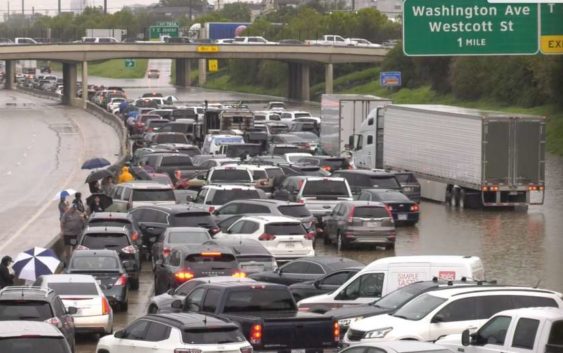- How to protect your car before a hailstorm
- ‘We lost everything’: East Texas residents confront their future after flooding
- Here's how to get your flooding debris picked up by the City of Houston
- Mosquito activity on the rise due to rainfall, flooding across Texas
- Volunteers help Conroe community clean up in wake of flooding in Montgomery County
How to find your towed car after Tropical Storm Imelda

-
Vehicles are stranded by high water on the Katy Freeway at Patterson after Tropical Depression Imelda soaked the Houston area on Thursday, Sept. 19, 2019.
Vehicles are stranded by high water on the Katy Freeway at Patterson after Tropical Depression Imelda soaked the Houston area on Thursday, Sept. 19, 2019.
Photo: Jay R. Jordan/Houston Chronicle
Vehicles are stranded by high water on the Katy Freeway at Patterson after Tropical Depression Imelda soaked the Houston area on Thursday, Sept. 19, 2019.
Vehicles are stranded by high water on the Katy Freeway at Patterson after Tropical Depression Imelda soaked the Houston area on Thursday, Sept. 19, 2019.
Photo: Jay R. Jordan/Houston Chronicle
Tropical Storm Imelda dumped more than 40 inches of rain across Southeast Texas, making it one of the wettest tropical systems to hit the United States.
In any big rain event, especially in Houston, the streets take the brunt of the water by design, which places cars, trucks and SUVs in the crosshairs for being flooded out or abandoned as their owners drive to high ground. Starting late Thursday, after Imelda inundated Houston, Harris County and several surrounding communities, law enforcement began towing vehicles that were left behind to a safe location.
How do you find where your car was towed?
If the vehicle was towed within the city of Houston, visit findmytowedcar.com. Once on the webpage, fill out the fields with your vehicle’s license plate number, VIN, year, make and model. You’ll also need to know what day and from where the vehicle was towed.
For drivers whose cars were towed in unincorporated Harris County, authorities say to call 713-221-6000 and press option number 1 when prompted.
These are numbers for communities outside of Harris County, according to KPRC-TV:
- Galveston County Sheriff’s Office (for vehicles in Galveston, La Marque, Texas City, Hitchcock, Bolivar, and Santa Fe): 409-766-2322
- Galveston County Sheriff’s Office (for vehicles in Dickinson, San Leon, League City, Bacliff, Kemah, Algoa and Friendswood): 281-534-3515
- Liberty County Sheriff’s Office: 912-876-2131
- Fort Bend County Sheriff’s Office: 281-341-4665
- Montgomery County Sheriff’s Office: 936-760-5871
- Waller County Sheriff: 979-826-8282
- Brazoria County Sheriff’s Office: 979-864-2338
Once back behind the wheel of your car, however, it’s important to check and see if it was flooded and – more importantly – if it’s operable. Sometimes, starting a car up after it took on water can do more damage.
Here is what the National Auto Dealers Association (NADA) recommends:
- Don’t start a flooded vehicle until a thorough inspection and cleaning is performed. Starting the car with water in the engine could cause more damage.
- Take immediate steps to dry the vehicle as much as possible to reduce the length of time vehicle components are exposed to water.
- Get the vehicle towed to higher ground if floodwaters are receding.
- Remove all moisture from the car if the interior got wet with a wet/dry vacuum. Remove seats if possible and use fans to quicken the drying process.
- Contact your insurance company or agent and promptly report the exposure of your vehicle to water or flood.
- Record the highest level of water exposure on a flooded vehicle.
- Contact a certified technician to arrange for an inspection and evaluation of all mechanical components, including the engine, transmission, axles, brake and fuel system for water contamination.
- Flush and replace all fluids, oils and lubricants, and replace all filters and gaskets for components exposed to water. While a vehicle may drive with fluids that have experienced water intrusion, extended internal exposure to water will increase the level of damage to the engine and other vehicle components.
- Many repair facilities recommend a thorough cleaning of brake parts and repacking of bearings, particularly for rear-drive vehicles. In front-wheel-drive vehicles, bearings are sealed.
- Some of today’s vehicles have padding and insulation that don’t easily release moisture. In this situation, it’s most effective to replace the materials to prevent the forming of mold or mildew that may contaminate the entire vehicle
Jay R. Jordan covers breaking news in the Houston area. Read him on our breaking news site, Chron.com, and our subscriber site, HoustonChronicle.com | Follow him on Twitter at @JayRJordan | Email him at jay.jordan@chron.com